The buildings and pavilions of the palace,
located at the foot of a mountain, were positioned more naturally, following
the contours of the land. Especially the rear garden is known to the Secret
Garden.
This palace was designated as a UNESCO World
Heritage in 1997 and is regarded as a masterpiece of Korean palace architecture
where the buildings are in perfect harmony with the natural setting.
◆ Transportation
- Entrance no. 3 at Ankuk Station of Subway Line 3
1. Donhwamun Gate
Donhwamun has a two-story, pavilion-type wooden structure, and is the largest
of all palace gates. In front of the gate there once was a broad, raised stone
terrace giving the gate an imposing dignity. A
bell and a drum were used to be hung on the second floor of Donhwamun; the bell
was rung to signal the beginning of curfew, and the drum was struck to signal
the end.
2. Geumcheongyo Bridge
Palaces of the Joseon Dynasty were built so that one could meet an auspicious stream. This stream was called ‘Geumcheon(禁川)’ because it defined the distinction between the inside and outside the palace. In 1411, the bridge was built over this stream and it was called ‘Geumcheongyo(錦川橋, bridge over the beautiful and silky stream)’. This bridge is known as the oldest stone bridge remaining in Seoul.
3. Injeonjeon
Injeongjeon is the throne hall of Changdeokgung. Major state affairs, including the coronation of a new king and reception of foreign envoys, took place here. Ceremonies were held in the courtyard; to the rear, a terraced garden rose up toward Maebong Peak. From the outside, Injeongjeon appears to have two stories, but inside it is a single space with a high, beautifully adorned ceiling.
4. Seonjeongjeon
Here the king worked at his convenience to discuss routine state affairs with high ranking officials. A long, narrow colonnaded structure surrounding the hall served as secretarial offices and provided storage. This is the only building in Changdeokgung with a blue-tiled roof.
5. Huijeongdang
Huijeongdang was used as the actual main hall of Changdeokgung, where the king spent most of his time. As the king’s office, Seonjeongjeon, was not large enough for conducting routine state affairs, Huijeongdang, which originally was the king’s bed chamber, came to serve as
his workplace. Huijeongdang was destroyed by fire in 1917, and the existing buildingwas rebuilt with materials taken from Gangnyeongjeon, the king’s residence at
Gyeongbokgung. The original Huijeongdang depicted on the Map of the East Palace
was an elegant building with a raised floor set on stone columns, and a pond in the
courtyard.
6. Daejojeon
7. Seongjeonggak
On the wide road leading to the Secret Garden, between Seongjeonggak and Nakseonjae, used to stand Junghuidang. This area was the crown prince’s residence, and was once home to many buildings. Junghuidang was removed in 1891, and the buildings that remain today are Samsamwa, a hexagonal pavilion; Chilbunseo; and Seunghwaru. All three were once connected by corridors and used as a library and for storing books.
8. Gwolnaegaksa
While many government offices were located outside the palace walls, some offices were built on the palace grounds and were collectively known as Gwolnaegaksa. In an area west of Injeongjeon, Naeuiwon (Royal infirmary), Hongmungwan (Office of Special Advisers), and Geomseocheong (Publication Office) were located to the east of Geumcheon Stream, and Gyujanggak (Royal Library) and Bongmodang (Hall of Upholding the Policies of Former Kings) were to the west.
9. Nakseonjae Complex
From the left, the buildings here are Nakseonjae, Seokbokheon and Sugangjae. Originally, the Donggung, which is the quarters of the crown prince, was on this site.
Nakseonjae was built as the king’s quarters in the reign of King Heonjong, in 1847. It was a very personal space built so that King Heonjong could relax and read. Though it was part of the palace, King Heonjong refrained from using colorful paint decorations, Dancheong. Meanwhile, Nakseonjae was used until the most recent days. Bangja Lee, who was the wife of the last crown prince lived here until 1989.
Seokbokheon was constructed in 1848. It was built for the Royal Lady Gyeongbin
who was chosen in order to give King Heonjong’s desired heir.Sugangjae was first built in 1785, later renovated in 1848 and turned into the quarters of Queen Sunwon, the grandmother of King Heonjong.
10. Secret garden
With palace architectures, a beautiful rear garden, also known as the Secret Garden, was created in Changdeokgung. This garden presents an unusually exquisite design. It is adapted to the topography and contains small hills and natural forests. The natural setting was accentuated by keeping artificial landscape to the minimum.
a. Buyongji and Juhamnu
This area is in the heart of the Secret Garden. It was a relatively open place used for retreats as well as study. A number of buildings were built around Buyongji, a rectangular pond. The royal libraries of Gyujanggak and Seohyanggak also stood in this area. State exams were conducted in front of Yeonghwadang Pavilion on special occasions, in the presence of the king.
Juhamnu Pavilion stands on the high ground and commands a fine view of pond.
b. Aeryeonji and Uiduhap
King Sukjong, the 19th king of the Joseon Dynasty, was said to have created an islet topped by a pavilion in the middle of the pond in 1692. The island disappeared, but the pavilion remains on the northern end of the pond. Sukjong named the pond ‘Aeryeon,’ meaning ‘loving the lotus flowers.’
In 1827, Crown Prince Hyomyeong built a number of structures to the west of Aeryeonji, including Uiduhap Pavilion, and erected a fence around this area. Uiduhap, which bears the sign ‘Gioheon’ at
present, is a modest study. Next to it is Ungyeonggeo. It is the smallest building in the palace.
c. YeonGyeongDang
Crown Prince Hyomyeong constructed YeonGyeongDang in about 1828 to celebrate the 40th birthday of his mother, and to present a title for his father, King Sunjo, the 23rd king of Joseon. The men’s and women’s quarters are separated, but inside they are connected, just like in a typical Joseon nobleman house. Unique styles of side walls and sun blinds under the copper-plated roof create a distinctive atmosphere Seonhyangjae, a study. Nongsujeong, situated on a high spot in the garden, bears a roof that resembles a hawk spreading its wings. Behind the women’s quarters is a kitchen.
d. Jondeokjeong
The double layered roof of Jondeokjeong was made by setting the upper roof into the eaves of the lower roof. Instead of supporting the outer roof with one large column, three columns were erected. In the center of the ceiling are twin painted dragons playing with Cintamani, a symbol of upright royal authority.
e. Ongnyucheon
The brook flowing through the deep valley north to the Secret Garden of Changdeokgung
is called Ongnyucheon. Sometimes the king and his officials set af loat their wine cups on the water while they wrote poetry. Five pavilions, Soyojeong, Taegeukjeong, Cheonguijeong, Nongsanjeong and Chwihanjeong, are located around Soyoam.
is called Ongnyucheon. Sometimes the king and his officials set af loat their wine cups on the water while they wrote poetry. Five pavilions, Soyojeong, Taegeukjeong, Cheonguijeong, Nongsanjeong and Chwihanjeong, are located around Soyoam.
f. New Seonwonjeon
The grounds of new Seonwonjeon are home to two pavilions: Mongdapjeong and Gwaegungjeong. Originally, this area did not belong to the garden of Changdeokgung Palace. A military camp once operated northwest of the garden, and Mongdapjeong was built in 1759 as a tower for the camp. As befits a pavilion in a military camp, Mongdapjeong is large and looks imposing. Gwaegungjeong on the north hill commanded a view of the camp’s archery field. ‘Gwaegung’ means ‘to draw a bow,’ indicating that the pavilion was a place from which archery practice was observed.
※ Please refer to the website of Changdeokgung Palace (http://eng.cdg.go.kr/main/main.htm) for more information. Most writings are copied from guidebook of Changdeokgung Palace.
※ Please refer to the website of Changdeokgung Palace (http://eng.cdg.go.kr/main/main.htm) for more information. Most writings are copied from guidebook of Changdeokgung Palace.
























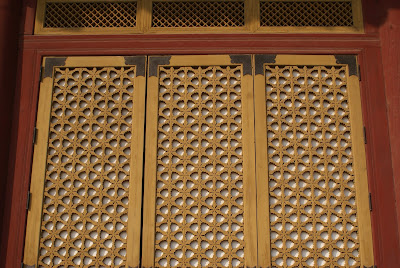



















































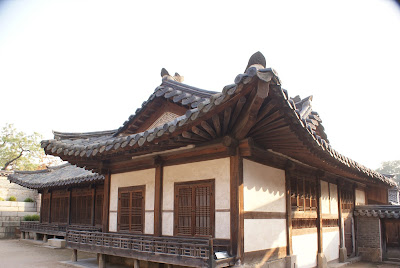


























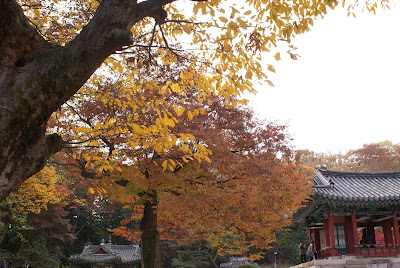







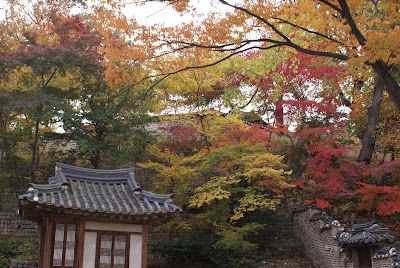

























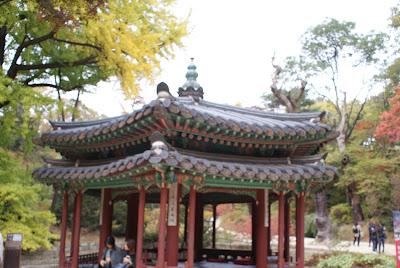

























댓글 없음:
댓글 쓰기